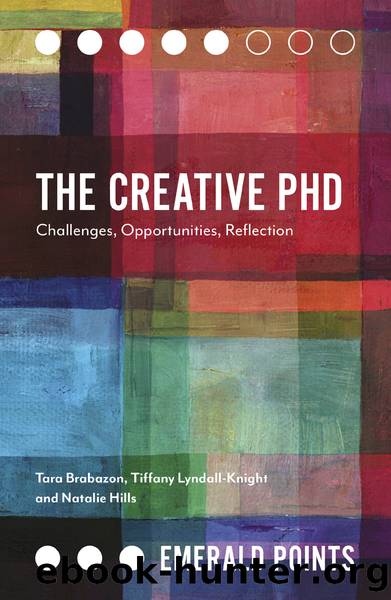The Creative PhD by Brabazon Tara;Lyndall-Knight Tiffany;Hills Natalie;

Author:Brabazon, Tara;Lyndall-Knight, Tiffany;Hills, Natalie;
Language: eng
Format: epub
Publisher: Emerald Publishing Limited
Published: 2020-05-29T00:00:00+00:00
THE BIAS OF COMMUNICATION
A key major historical concept and theory emerged late in the career of the Canadian professor Harold Innis. He was born in 1894 and died in 1952. He lived through the change from newspaper culture to television culture and the development of a national communication system that could move ideas beyond borders and into international audiences. There was a social and political context for the development of Innisâs ideas. The educational system into which Innis was educated and worked was dominated by British born and educated academics who demeaned and displaced Canadian scholars and research. The colonization that continued through the twentieth century rarely revealed the brutalizing violence of the previous century, but instead was insidious and corrosive. Similarly, Canadian academics had to manage the expansive and chaotic power of a burgeoning United States over the border (Creighton, 1978). Innis was the first Canadian academic who valued the university system and Canadian research voice on its own terms, rather than as a second rate, faded British duplicate, or as a shadow of the United States (Creighton, 1978).
In his own time, Harold Innis was a famous academic. He was a distinguished historian and political economist through almost all of his career and he researched important and earnest â if boring â topics (Innis, 1956). He explored the building of the Canadian railway system, considering how the large spaces and intricate landscape of the nation could be managed. His other major research projects included Fur Trade in 1939 and The Cod Fisheries, published in 1940.
This is a conventional scholarly tale. But what makes the tail of Innisâs career remarkable is that he had, to cite Edward Said, a âlate styleâ (Said, 2007). His tail had a scorpion lash. At the point where most academics would remain in a research area where they had respect, reputation and credibility, he moved away from economics and started to study communication (Christian, 1980). His project was expansive and powerful, investigating the relationship between the medium of communication and the configuration of identity. Suddenly, he became interested in incredibly large social variables: time and space. He also became focused on the notion â that became a conceptualization â of âbias.â3 The commonsensical interpretation of bias involves politicians, journalists or citizens expressing a staunch and blinkered view of the world. Innisâs interpretation was distinct. He argued that each society has been dominated by a different medium of communication through history: clay, papyrus, parchment and paper. His argument could be updated with ease to include digitized screens as the contemporary end of that list. Innis demonstrated that each medium creates a different monopoly of knowledge. Knowledge and power are differently constituted depending on the dominant medium of the era, and its bias to space and time. Furthermore, he argues that a society that balances space-oriented media (the platforms that move ideas through the landscape) and time-oriented media (the platforms that move ideas beyond a singular era) will be successful in space and time.
This tale continues through Innisâs student.
Download
This site does not store any files on its server. We only index and link to content provided by other sites. Please contact the content providers to delete copyright contents if any and email us, we'll remove relevant links or contents immediately.
Chicken Soup for the Soul Presents Teens Talkin' Faith by Jack Canfield(688)
Understanding PDA Autism in Kids: A Guide for Parents and Teachers to Support Neurodiverse Learners by Jehu Len(557)
The Victorian Era: A Captivating Guide to the Life of Queen Victoria and an Era in the History of the United Kingdom Known for Its Hierarchy-Based Social Order by Captivating History(428)
Brain Teasers to Build Critical Thinking Skills: Brain Exercises for Tech, Banking, Case Interview Prep, and to Keep Your Mind Sharp by Kris Safarova(414)
Brain Teasers to Build Critical Thinking Skills by Safarova Kris(412)
100 Ideas for Secondary Teachers: Engaging Parents by Janet Goodall & Kathryn Weston(390)
Python 101 - Fundamentals by Sam(374)
Critical Curriculum Leadership : A Framework for Progressive Education by Rose M. Ylimaki(365)
Writing Solid Code: Development Philosophies for Writing Bug-Free Programs by Steve Maguire(360)
The Art of Emotional Validation: Improve Your Communication Skills and Transform Your Relationships by Validating Emotions and Feelings by Emily Wright(339)
Intersectionality in Educational Research by Dannielle Joy Davis; James L. Olive; Rachelle J. Brunn-Bevel; Susan R. Jones(335)
The Knights Templar: An Enthralling History of the Rise and Fall of the Most Influential Catholic Military Order by Wellman Billy(330)
A Beginner's Guide to SSD Firmware by Unknown(328)
The Future Knowledge Compendium by Ellyard Peter;(319)
How to be assertive in any situation by Hadfield Sue & Hasson Gill(310)
Foundations of Educational Research by Victoria Elliott(307)
Making Connections in and Through Arts-Based Educational Research by Hala Mreiwed Mindy R. Carter Sara Hashem Candace H. Blake-Amarante(306)
What Every Teacher Should Know about Learning, Memory, and the Brain by Tileston Donna E. Walker;(306)
Message from the Pleiades; The Contact Notes of Eduard Billy Meier v1 only by unknow(302)
